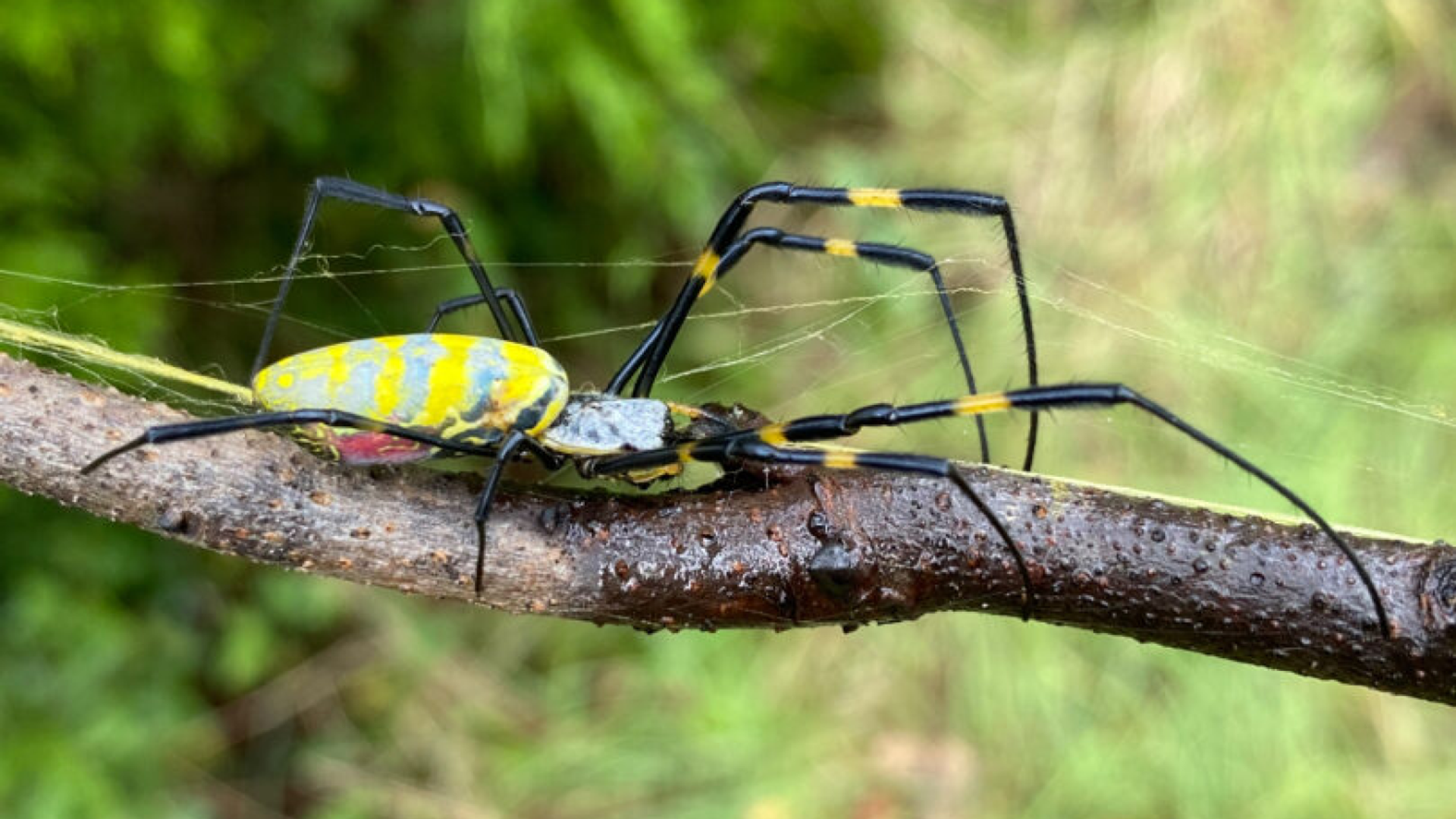https://sputnikglobe.com/20220309/scientists-warn-giant-japanese-orb-weaver-spider-could-become-endemic-to-north-america-1093701701.html
Scientists Warn Giant Japanese Orb Weaver Spider Could Become Endemic to North America
Scientists Warn Giant Japanese Orb Weaver Spider Could Become Endemic to North America
Sputnik International
Naturalists in the American Northwest have labored in recent years to stop a deadly species of Asian hornet, nicknamed the “murder hornet” for its killing... 09.03.2022, Sputnik International
2022-03-09T01:12+0000
2022-03-09T01:12+0000
2022-08-06T13:28+0000
spider
invasive species
north america
us
https://cdn1.img.sputnikglobe.com/img/07e6/03/09/1093701582_0:35:1501:879_1920x0_80_0_0_ab38b9b69011a63196941d10d869e6b8.png
A new study has found that the Joro spider might have the physical attributes necessary to survive in colder North American climates than just the warmer southeastern areas where it’s been spotted in recent years.The yellow, black and red spider is native to East Asia, but it could now become endemic to North America. However, while the spiders spin large webs and are of an intimidating size - an adult female can be 3 inches long from toe to toe - their bite is painful but not medically significant. Additionally, their impact on the environment seems to be small.The Joro spider spins massive, intricate webs to catch its insectoid prey, and it also uses its silk to create a “parachute” that can carry it a significant distance on the wind. However, it likely arrived in North America in a shipping container and not by riding the thermals across the ocean.Another species of invasive bug from East Asia, the Asian Giant Hornet, aroused fear due to its deadly sting, and authorities on the West Coast have worked for two years to try and stop the hornet from establishing a permanent presence on the continent. The massive insects can kill an adult human with their sting, and are infamous for slaughtering their way through the hives of honeybees, giving them the unsettling but not-entirely-inappropriate nickname of “murder hornet.”Benjamin Frick, a co-author of the study and an undergraduate researcher in the School of Ecology, cautioned that when it comes to the Joro spider, “there’s no point in excess cruelty where it’s not needed.”In fact, they could prove to be a benefit. The large insects will be a plentiful food source for birds or other animals, and they seem to have an appetite for the brown marmorated stink bug, another invasive species of insect that native spiders don’t like to eat.
north america
Sputnik International
feedback@sputniknews.com
+74956456601
MIA „Rossiya Segodnya“
2022
Sputnik International
feedback@sputniknews.com
+74956456601
MIA „Rossiya Segodnya“
News
en_EN
Sputnik International
feedback@sputniknews.com
+74956456601
MIA „Rossiya Segodnya“
Sputnik International
feedback@sputniknews.com
+74956456601
MIA „Rossiya Segodnya“
spider, invasive species, north america, us
spider, invasive species, north america, us
Scientists Warn Giant Japanese Orb Weaver Spider Could Become Endemic to North America
01:12 GMT 09.03.2022 (Updated: 13:28 GMT 06.08.2022) Naturalists in the American Northwest have labored in recent years to stop a deadly species of Asian hornet, nicknamed the “murder hornet” for its killing sprees through honeybee hives, from permanently establishing itself in North America. Now another invasive species on the opposite end of the country is making itself at home.
A new study has found that the Joro spider might have the physical attributes necessary to survive in colder North American climates than just the warmer southeastern areas where it’s been spotted in recent years.
Scientists at the University of Georgia reported in a recent study, published in the journal Physiological Entomology, that the Joro spider’s high metabolism, heart rate, and tolerance of cold mean it is capable of breaking out of a relatively small area of northern Georgia and western South Carolina where it has existed since 2013.
The yellow, black and red spider is native to East Asia, but it could now become endemic to North America. However, while the spiders spin large webs and are of an intimidating size - an adult female can be 3 inches long from toe to toe - their bite is painful but not medically significant. Additionally, their impact on the environment seems to be small.
“People should try to learn to live with them,” Andy Davis, corresponding author of the study and a research scientist in the Odum School of Ecology, said in a
UGA press release. “If they’re literally in your way, I can see taking a web down and moving them to the side, but they’re just going to be back next year.”
The Joro spider spins massive, intricate webs to catch its insectoid prey, and it also uses its silk to create a “parachute” that can carry it a significant distance on the wind. However, it likely arrived in North America in a shipping container and not by riding the thermals across the ocean.
Another species of invasive bug from East Asia, the Asian Giant Hornet, aroused fear due to its deadly sting, and authorities on the West Coast have
worked for two years to try and stop the hornet from establishing a permanent presence on the continent. The massive insects can kill an adult human with their sting, and are infamous for slaughtering their way through the hives of honeybees, giving them the unsettling but not-entirely-inappropriate nickname of “murder hornet.”
Benjamin Frick, a co-author of the study and an undergraduate researcher in the School of Ecology, cautioned that when it comes to the Joro spider, “there’s no point in excess cruelty where it’s not needed.”
“You have people with saltwater guns shooting them out of the trees and things like that, and that’s really just unnecessary,” he explained. “There’s really no reason to go around actively squishing them. Humans are at the root of their invasion. Don’t blame the Joro spider.”
In fact, they could prove to be a benefit. The large insects will be a plentiful food source for birds or other animals, and they
seem to have an appetite for the brown marmorated stink bug, another invasive species of insect that native spiders don’t like to eat.


